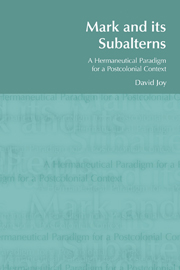Book contents
- Frontmatter
- Contents
- Foreword
- Acknowledgements
- 1 General Introduction
- PART I Hermeneutics: General Methodological Considerations
- PART II Mark – Context and Interpretation
- 4 Colonial Powers and their Marks in Mark
- 5 Mark and its Subalterns: A Product of Conflict and Resistance?
- 6 Mark 10:17–31 in the Light of the Issues of the Poor and their Representation: A Postcolonial Reading
- 7 Mark 7:24–30 in the Light of Race, Gender and Hybridity: A Postcolonial Reading
- 8 Mark 5:1–20 in the Light of the Issues of Class, Nationalism and Subalternity: A Postcolonial Biblical Reading
- 9 General Conclusions: Hermeneutical Issues and Concluding Summary
- Endnotes
- References
6 - Mark 10:17–31 in the Light of the Issues of the Poor and their Representation: A Postcolonial Reading
from PART II - Mark – Context and Interpretation
- Frontmatter
- Contents
- Foreword
- Acknowledgements
- 1 General Introduction
- PART I Hermeneutics: General Methodological Considerations
- PART II Mark – Context and Interpretation
- 4 Colonial Powers and their Marks in Mark
- 5 Mark and its Subalterns: A Product of Conflict and Resistance?
- 6 Mark 10:17–31 in the Light of the Issues of the Poor and their Representation: A Postcolonial Reading
- 7 Mark 7:24–30 in the Light of Race, Gender and Hybridity: A Postcolonial Reading
- 8 Mark 5:1–20 in the Light of the Issues of Class, Nationalism and Subalternity: A Postcolonial Biblical Reading
- 9 General Conclusions: Hermeneutical Issues and Concluding Summary
- Endnotes
- References
Summary
Introduction
In the light of the results of the explorations of the imperial elements in Mark and of the possibility of using postcolonial hermeneutics for interpreting Mark presented in the previous chapter, it is relevant to look at some issues related to the poor in Mark and their representation in the Gospel and consequent interpretations of the Gospel of Mark. The issues of the poor, representation, economics, labour, tax, liberation and Jubilee are visible in several passages of Mark. Needless to say, many concerns visible in Mark seem to be postcolonial as the Gospel of Mark was a product of the colonial era of Roman imperialism. This study considers Mark in the light of these issues and in the living context of today as the author hails from a postcolonial situation. This section will look at the theological position of Mark as well as the theological position of the Markan interpreters on these issues. This chapter will have three main parts, namely a discussion on the issue of the poor in Mark, an exegetical study of Mark 10:17–31 and a postcolonial reading of that passage. In addition to this, there will be an evaluation of the historical-critical interpreters of the text. In the light of their interpretations of the issues of the poor in Mark, a postcolonial reading might offer some possible guidelines for constructing a hermeneutical paradigm for the postcolonial context.
- Type
- Chapter
- Information
- Mark and its SubalternsA Hermeneutical Paradigm for a Postcolonial Context, pp. 124 - 142Publisher: Acumen PublishingPrint publication year: 2008

